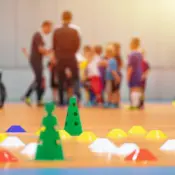
9 Ways to Make Moving Easier for Young Children
April 18, 2021 | Moving
Moving is stressful for people of all ages, but young children are especially sensitive to moving. While there is excitement about moving to a new home, leaving behind friends and a familiar neighborhood can create anxiety for your child. Read on for some ideas on how to ease one of life’s biggest transitions for young children.
Fortunately, there are many ways to make moving with children easier for the entire family. A lot comes down to good planning. If you can plan the move well in advance, keeping the following tips in mind, you can help your child adjust faster and feel happier during the move.
1. Talk About the Move Frequently
Young children need time to understand and process what “moving” means. For this reason, it’s best to break the news early on, at least a month in advance if possible. Then, make the move a regular topic of conversation. Mention it several times a week, even every day.
Adults and adolescents typically get tired of this kind of repetition, but children crave it. They learn and understand things through repetition, and for something as big as a move, there’s a lot to learn.
Talk about all the activities related to moving, like packing boxes, choosing a new home, etc. You can enrich the conversation by reading children’s books about moving. You can also download this free-moving-themed app from Sesame Street called The Big Moving Adventure. With this prep work, the move will seem more familiar and less scary for your child.
2. Show Them What Their New Home and Neighborhood Will Look Like
Another source of stress for young children is the strangeness of the place you’re moving to. You can help them feel more comfortable in their new home and community if you visit the place beforehand.
Visiting several times is ideal, but if this isn’t possible, you can at least look at pictures of the neighborhood and house together online.
When you tour the area, try to make the experience fun for your child. Do things they love, like visiting an ice cream shop or playing in a local park. This fun trip isn’t just good for your child. It can also help you feel less stressed about the move as you familiarize yourself with the area.
3. Involve Them in Decisions and Chores

Sometimes, children feel upset during a move simply because they’re pushed aside. They feel unwanted and powerless about something that deeply affects their life. Everything is getting turned upside down, and they have no control over anything.
Of course, it’s easier to do everything yourself rather than delegate to your child, but it can make a huge difference in their mood. Think of little things they could help with or might enjoy doing. These tasks don’t even have to be strictly necessary for the move. For example, your child could decorate the boxes with stickers and drawings.
Giving them some control over decisions can be a game-changer, too. For instance, they can decide where or what to eat for dinner, or which color to paint the walls of their new room.
Allowing your children to make these small choices can help them feel in control of the whole situation, even though you’re deciding everything else.
4. Pack Fun Activities in a Special Box or Bag that’s Easily Accessible
When you’re packing suitcases and boxes, think carefully about which items are essential for your child’s comfort and happiness. Think longer than a day or two. Imagine weeks. After all, moving and unpacking can take a long time. Pack some of their favorite toys and activities so they’re at your fingertips.
You want to have all of these essentials close by from day one in case your child asks for them. If your child is anxious about leaving something behind, pack these items together. Then, they’ll know for sure that everything they love is coming along.
5. Keep to the Same Schedule as Much as Possible
Young children love routines. A good routine is comfortingly familiar and can help your child cope with the chaos and strangeness of everything else. With this in mind, try to stick to your child’s usual schedule during the move and through the first weeks in your new home.
For example, if they’re used to getting a certain snack at a certain time, make sure that happens. If you read together before bed, make sure you have a few of their favorite books on hand.
Though it can be hard to stick to a child’s schedule when you’re busy with the move, remember how important it is to your child’s wellbeing. Changing a home and community is already hard. Adding a change in schedule, too, might push your child beyond their limits.
6. Stay Calm and Positive

Children are incredibly perceptive. They watch how you react to situations and base their own behavior partly on that. Through these observations, they also learn what situations are safe or unsafe, good or bad. In the context of moving, your behavior can be a powerful message that either comforts or stresses your child.
At the same time, allow your child to express their grief. Remaining positive while also empathizing with your child’s sadness can be a difficult balance sometimes—but it can also be as simple as listening to them without any judgment or problem-solving. Just listening. They don’t need “words of wisdom” or a host of solutions to cope with their feelings. Being available for hugs and empathy is already meaningful enough.
7. Create Time for Goodbyes
Closure is important for everyone, even young children. That’s why it’s crucial to set aside time for goodbyes. These goodbyes can include anything from a favorite babysitter to a part of the house they love, like their room.
Consider taking pictures during these goodbyes, too. For instance, you might snap a picture of every room in the house. You can also take pictures of special people your child is leaving behind, like friends. These photos can provide comfort when your child is missing their old life or feeling overwhelmed by the strangeness of their new life.
8. Build Friendships with Other Young Children in the Community
After you’ve moved and begun to settle in, start thinking about ways to introduce your child to the community. Look for places where children gather and play, like the local library or playground. Perhaps you can join a playgroup or enroll in a fun class for kids, like music or swimming.
Social ties can mean a lot to a child. If they make new friends and acquaintances in the area, they might recover from the change faster.
Though grief is still normal for a while (even up to 6 months), new friends can help relieve their sadness. With good friends and fun outings, they will eventually grow as attached to their new home as their old one.
9. Find a New Social System Early and Build Positive Experiences

One of the biggest problems children have with moving is the interruption to their social network. Kids who move frequently are more likely to have difficulty maintaining relationships, which means you should prioritize finding a new social system for your child as soon as possible. This can be a local children’s club during the summer, or it can mean enrolling them in school and after-school clubs as soon as possible. Arrange playmates with local mothers, bring your children to local parks and libraries as soon as you can.
Save Memories in a Self Storage Unit
Of course you want to make sure that your children have memories and keepsakes of your old home, but you may not have room for everything. This is where a storage unit can come in handy to hold onto a few extra keepsakes you don’t want around the house. With a self storage unit, you can create a time capsule of sorts of your child’s memories living in your old home. From childhood time capsules to additional storage, you and your child can both benefit from a self storage unit at Metro Self Storage. Featuring flexible access hours, month-to-month leases, and convenient amenities and features, finding a little extra space is as easy as locating a facility near you and renting your unit online today!



